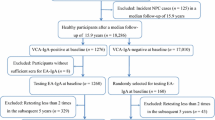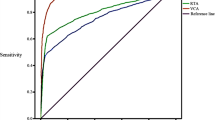Abstract
The linear antigenic epitopes of the Epstein-Barr virus replication activator protein (ZEBRA), recognised by specific serum IgG in nasopharyngeal carcinoma (NPC), were determined. This was achieved by synthesizing the entire amino acid sequence of ZEBRA as a set of 29, 22-residue peptides with an overlap of 14 amino acids. The ZEBRA peptides were tested in enzyme-linked immunosorbent assay (ELISA) for IgG binding in sera from 37 selected NPC patients who had IgG antibodies to the native ZEBRA protein. The most immunogenic epitope was peptide 1 at the amino-terminal end with 36 of the sera reactive against it. Further analysis of peptide 1, using the multipin peptide-scanning technique, defined a 10-amino-acid sequence FTPDPYQVPF, which was strongly bound by IgG. Two other regions of ZEBRA were also identified as immunodominant IgG epitopes, namely peptide 11 (amino acids 82–103) and peptide 19/20 (amino acids 146–175) with 8–13 of the NPC sera reactive against the peptides. The number of peptides reactive with individual NPC serum varies from 1 to 6 or more and there is some correlation between a greater number of peptide (at least 4) bound and a higher (at least 1:40) titre of serum IgA to viral capsid antigen. The immunodominant ZEBRA peptide 1 could be utilised in IgG ELISA for the detection of NPC.
Similar content being viewed by others
References
Apolloni A, Moss D, Stumm R, Burrows S, Suhrbier A, Misko I, Schmidt C, Sculley T (1992) Sequence variation of cytotoxic T cell epitopes in different isolates of Epstein-Barr virus. Eur J Immunol 22:183
Bastin J, Rothbard J, Davey J, Jones I, Townsend A (1987) Use of synthetic peptides of influenza nucleoprotein to define epitopes recognised by class 1-restricted cytotoxic T lymphocytes. J Exp Med 165:1508
Brooks L, Yao QY, Rickinson AB, Young LS (1992) Epstein-Barr virus latent gene transcription in nasopharyngeal carcinoma cells: coexpression of EBNA 1, LMP 1, and LMP 2 transcripts. J Virol 66:2689
Burt RD, Vaughan TC, Nisperos B, Swanson M, Berwick M (1994) Protective association between HLA-A2 antigen and nasopharyngeal carcinoma in US Caucasians. Int J Cancer 56:465
Chang YN, Dong DL, Hayward GS, Hayward SD (1990) The Epstein-Barr virus Zta transactivator: a member of the bZIP family with unique DNA-binding specificity and a dimerization domain that lacks the characteristic heptad leucine zipper motif. J Virol 64:3358
Chen Y, Chan SH (1994) Polymorphism of T cell receptor genes in nasopharyngeal carcinoma. Int J Cancer 56:830
Cheng HM, Foong YT, Sam CK, Prasad U, Dillner J (1991) Epstein-Barr virus nuclear antigen 1 linear epitopes that are reactive with immunoglobulin A (IgA) or IgG in sera from nasopharyngeal carcinoma patients or from healthy donors. J Clin Microbiol 29:2180
Cochet C, Martel-Renoir D, Grunewald V, Bosq J, Cochet G, Schwaab G, Bernaudin J-F, Joab I (1993) Expression of the Epstein-Barr virus immediate-early gene, BZLF1, in nasopharyngeal carcinoma tumor cells. Virology 197:358
De-Vathaire F, Sancho-Garnier H, The Hde, Pieddeloup C, Schwaab G, Ho JHC, Ellouz R, Micheau C, Cammoun M, Cachin Y, The Gde (1988) Prognostic value of EBV markers in the clinical management of nasopharyngeal carcinoma-a multicenter follow-up study. Int J Cancer 42:176
Dillner J, Szigeti R, Henle W, Henle G, Lerner RA, Klein G (1987) Cellular and humoral immune responses to synthetic peptides deduced from the amino-acid sequences of Epstein-Barr virus-encoded proteins in EBV-transformed cells. Int J Cancer 40:455
Dillner J, Dillner L, Robb J, Willems J, Jones I, Lancaster W, Smith R, Lerner R (1989) A synthetic peptide defines a serologic IgA response to a human papillomavirus-encoded nuclear antigen expressed in virus-carrying cervical neoplasia. Proc Natl Acad Sci USA 86:3838
Ferradini L, Miescher S, Stoeck M, Busson P, Barras C, Cerf-Bensussan N, Lipinski M, von Fliedner V, Tursz T (1991) Cytotoxic potential despite impaired activation pathways in T lymphocytes infiltrating nasopharyngeal carcinoma. Int J Cancer 47:362
Foong YT, Cheng HM, Sam CK, Dillner J Hinderer W, Prasad U (1990) Serum and salivary IgA antibodies against a defined epitope of the Epstein-Barr virus nuclear antigen (EBNA) are elevated in nasopharyngeal carcinoma. Int J Cancer 45:1061
Geysen HM, Rodda SJ, Mason TJ, Tribbick G, Schoofs PG (1987) Strategies for epitope analysis using peptide synthesis. J Immunol Methods 102:259
Hildesheim A, Levine PH (1993) Etiology of nasopharyngeal carcinoma — a review. Epidemiol Rev 15:466
Houghten RA (1985) General method for the rapid solid-phase synthesis of large numbers of peptides: specificity of antigenantibody interaction at the level of individual amino-acids. Proc Natl Acad Sci USA 82:5131
Houghten RA, Bray MK, Degraw ST, Kirby CJ (1986) Simple procedure for carrying out simultaneous multiple hydrogen fluoride cleavages of protected peptide resins. Int J Peptide Protein Res 27:675
Joab I, Nicolas JC, Schwaab G, The Gde, Clausse B, Perricaudet M, Zeng Y (1991) Detection of anti-Epstein-Barr virus transactivator (ZEBRA) antibodies in sera from patients with nasopharyngeal carcinoma. Int J Cancer 48:647
Kenney S, Kamine J, Holley-Guthrie E, Lin JC, Mar EC, Pagano J (1989) The Epstein-Barr virus (EBV) BZLF1 immediate-early gene product differentially affects latent versus productive EBV promoters. J Virol 63:1729
Lee SP, Thomas WA, Murray RJ, Khanim F, Kaur S, Young LS, Rowe M, Kurilla M, Rickinson AB (1993) HLA A2.1-restricted cytotoxic T cells recognizing a range of Epstein-Barr virus isolates through a defined epitope in latent membrane protein LMP2. J Virol 67:7428
Lu SJ, Day NE, Degos L, Lepage V, Wang PC, Chan SH, Simons M, McKnight B, Easton D, Zeng Y, The Gde (1990) Linkage of nasopharyngeal carcinoma susceptibility locus to HLA region. Nature 346:470
Luka J, Deeb ZE, Hartmann DP (1988) Detection of antigens associated with Epstein-Barr virus replication in extracts from biopsy specimens of nasopharyngeal carcinomas. J Natl Cancer Inst 80:1164
Manet E, Gruffat H, Trescol-Biemont MC, Moreno N, Chambard P, Giot JF, Sergeant A (1989) Epstein-Barr virus bicistronic mRNAs generated by facultative splicing code for two transcriptional trans-activators. EMBO J 8:1819
Mathew A, Cheng HM, Sam CK, Joab I, Prasad U (1994) A high incidence of serum IgG antibodies to the Epstein-Barr virus replication activator protein in nasopharyngeal carcinoma. Cancer Immunol Immunother 38:68
Middeldorp JM, Meloen RH (1988) Epitope mapping on the Epstein-Barr virus major capsid protein using systematic synthesis of overlapping oligopeptides. J Virol Methods 21:147
Miller G (1989) The switch between EBV latency and replication. Yale J Biol Med 62:205
Miller G, Mimmelfarb H, Heston L, Countryman J, Gradoville L, Baumann R, Chi T, Carey M (1993) Comparing regions of the Epstein-Barr virus ZEBRA protein which function as transcriptional activating sequences inSaccharomyces cerevisiae and in B cells. J Virol 67:7472
Moriarty AM, Alexander H, Lerner RA, Thornton RB (1985) Antibodies to peptides detect new hepatitis B antigen: serological correlation with hepatocellular carcinoma. Science 227:427
Norrby E, Mufson MA, Alexander H, Houghten RA, Lerner RA (1987) Site-directed serology with synthetic peptides representing the large glycoprotein G of respiratory syncytial virus. Proc Natl Acad Sci USA 84:6572
Novotny J, Handschumacher M, Bruccoleri RE (1987) Protein antigenicity — a static surface property. Immunol Today 8:26
Oshima M, Atassi Z (1989) Comparison of peptide-coating conditions in solid phase plate assays for detection of antipeptide antibodies. Immunol Invest 18:841
Packham G, Economu A, Rooney CM, Rowe DT, Farrell PJ (1990) Structure and function of the Epstein-Barr virus BZLF1 protein. J Virol 64:2110
Prasad U, Rampal L (1992) Descriptive epidemiology of nasopharyngeal carcinoma in Peninsular Malaysia. Cancer Causes Controls 3:179
Raab-Traub N, Flynn K (1986) The structure of the termini of Epstein-Barr virus as a marker of clonal cellular proliferation. Cell 47:883
Saint-Clair AJ, Brimmell M, Farrell PJ (1992) Reciprocal antagonism of steroid hormones and BZLF1 in switch between Epstein-Barr virus latent and productive cycle gene expression. J Virol 66:70
Sam CK, Prasad U, Pathmanathan R (1989) Serological marker in the diagnosis of histopathological types of nasopharyngeal carcinoma. Eur J Sur Oncol 15:357
Smith RS, Naso RB, Rosen J, Whalley A, Hom YL, Hoey K, Kennedy CJ, McCutchan JA, Spector S, Richman DD (1987) Antibody to a synthetic oligopeptide in subjects at risk for the immunodeficiency virus infection. J Clin Microbiol 25:1498
Takada K, Ono Y (1989) Synchronous and sequential activation of latently infected Epstein-Barr virus genomes. J Virol 63:445
Tam JP, Heath WF, Merrifield RB (1983) Sn2 deprotection of synthetic peptides with a low concentration of HF in dimethyl sulfide: evidence and application in peptide synthesis. J Am Chem Soc 105:6442
Trumper PA, Epstein MA, Giovanella BC, Finerty S (1977) Isolation of infectious EB virus from the epithelial tumour cells of nasopharyngeal carcinoma. Int J Cancer 20:655
Urier G, Buisson M, Chambard P, Sergeant A (1989) The Epstein-Barr virus early protein EB1 activates transcription from different responsive elements including AP-1 binding sites. EMBO J 8:1447
Van Regenmortel MHV (1986) Which structural features determine protein antigenicity? Trends Biochem Sci 11:36
Van Regenmortel MYV (1987) Antigenic cross-reactivity between proteins and peptides — new insights and applications. Trends Biochem Sci 12:237
Yu MC, Garabrant DH, Huang T-B, Henderson BE (1990) Occupational and other non-dietary risk factors for nasopharyngeal carcinoma in Guangzhou, China. Int J Cancer 45:1033
Author information
Authors and Affiliations
Rights and permissions
About this article
Cite this article
Cheng, HM., Foong, YT., AbuSamah, A.J. et al. Linear epitopes of the replication-activator protein of Epstein-Barr virus recognised by specific serum IgG in nasopharyngeal carcinoma. Cancer Immunol Immunother 40, 251–256 (1995). https://doi.org/10.1007/BF01519899
Received:
Accepted:
Issue Date:
DOI: https://doi.org/10.1007/BF01519899




